OCTRI BERD Research Forum: Sample size considerations for “omics” data (and other fishing expeditions)
Presenter: Jack Wiedrick, M.S. M.A.
| When |
January 29, 2024
1 p.m. to 2 p.m.
|
|---|---|
| Where |
Please Register on Compass for more information |
| Contact Information |

When planning a study with hundreds or thousands of outcome measurements at a time, questions about statistical power become ambiguous: It's not just more decisions, but more ways the decisions can be arranged. When the focus shifts from one study effect to many, our natural inclination is to order features by how convincing we find the effect sizes. A big treatment effect seems compelling, but what if the measurement is highly variable, or even unreliable? How should we take correlation across measurements into account? And how convincing does a feature need to be to justify spending resources to learn more about it?
Prior knowledge is the key to a trustworthy forecast of the likelihood of success for your experimental venture, but there are times when prior knowledge is utterly lacking and yet we still need to justify the value of the research. This is particularly true for expensive new "omics" studies that yield oodles of measurements at a time, most of which are irrelevant to the research question. But for the ones that are not irrelevant, how much is the promise of that information worth to you? Forget about hypothesis tests and alpha levels and all that jazz! You're here on a fishing expedition, but no one will be convinced if you try to pretend the fish will just jump right out of the water for you, lining up like suckers to be counted. What an angler needs to know is Will my equipment be adequate? That's what we'll talk about: Equipping yourself statistically for fishing success, what that costs in terms of sample size, and what it can deliver in power to reel in the occasional fish.
Recommended background: A basic understanding of the usual ingredients of a power analysis and knowledge of things like the normal distribution will be helpful. Some of these concepts were introduced in the introductory seminar in this series, Power and Sample Size 101, and the current seminar will recap those concepts only briefly. The recording and slides from the introductory seminar are available online.
Register via Compass. Seminar will be recorded.
Questions? Contact Amy Laird: laird@ohsu.edu
If you have a disability and need an accommodation to attend or participate in this event, please contact Amy Laird (laird@ohsu.edu) at least five business days before the event.
Photo: Belted Kingfisher, Eugene. Norman Goo.